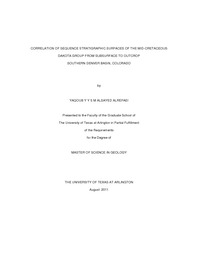
ATTENTION: The works hosted here are being migrated to a new repository that will consolidate resources, improve discoverability, and better show UTA's research impact on the global community. We will update authors as the migration progresses. Please see MavMatrix for more information.
Show simple item record
| dc.contributor.author | Alrefaei, Yaqoub Y Y S M Alsayed | en_US |
| dc.date.accessioned | 2011-10-11T20:48:30Z | |
| dc.date.available | 2011-10-11T20:48:30Z | |
| dc.date.issued | 2011-10-11 | |
| dc.date.submitted | January 2011 | en_US |
| dc.identifier.other | DISS-11236 | en_US |
| dc.identifier.uri | http://hdl.handle.net/10106/6162 | |
| dc.description.abstract | The D and J sandstone of the Cretaceous Dakota Group are considered as the major oil and gas producing units within in the Denver Basin. The distribution of these units in the Denver Basin is a sub-basin of the Early Cretaceous Western Interior Basin .These units are well understood within the northern Denver Basin and the linkage between the subsurface units and their equivalents in outcrop in the Front Range is well-established. They have gained less attention in southern parts of the basin and the linkage between the subsurface units and their equivalents in southern outcrop is not yet established. The main purpose of the study is to investigate the linkage between the subsurface Dakota Group units within the southern Denver Basin and their equivalents in outcrop of southeastern Colorado. This was achieved by correlating sequence stratigraphic surfaces within Dakota Group strata in the Denver Basin using well-log data and then correlating these surfaces with their age-equivalents in outcrop of southeastern Colorado. By proving this linkage, a better understanding for the correlation of Dakota Group strata from subsurface to outcrop is represented in southeastern part of Denver Basin which can be used as a tool in future research in the area and can forward regional paleogeographic reconstruction for this time interval. Paleogeography, deposition and distribution of the J and D Sandstone were illustrated in the study using the Buffer and Buttress model. Valleys intersection of different generation at the same stratigraphic level in both the J and D Sandstone were observed in the study area and were explained also by using the Buffer and Buttress model. The subsurface Huntsman Shale continuation in southern the Denver Basin to surface exposure in southeastern Colorado outcrops was proved based on thickness trend, fossil assemblage, and facies which in order constrained the correlation of the subsurface Dakota Group units with their surface equivalents in outcrop southeast Colorado. | en_US |
| dc.description.sponsorship | Holbrook, John | en_US |
| dc.language.iso | en | en_US |
| dc.publisher | Geology | en_US |
| dc.title | Correlation Of Sequence Stratigraphic Surfaces Of The Mid-cretaceous Dakota Group From Subsurface To Outcrop Southern Denver Basin, Colorado. | en_US |
| dc.type | M.S. | en_US |
| dc.contributor.committeeChair | Holbrook, John | en_US |
| dc.degree.department | Geology | en_US |
| dc.degree.discipline | Geology | en_US |
| dc.degree.grantor | University of Texas at Arlington | en_US |
| dc.degree.level | masters | en_US |
| dc.degree.name | M.S. | en_US |
Files in this item
- Name:
- Alrefaei_uta_2502M_11236.pdf
- Size:
- 4.021Mb
- Format:
- PDF
This item appears in the following Collection(s)
Show simple item record


